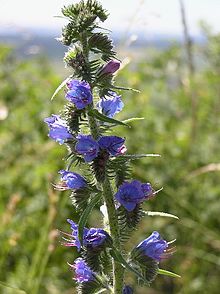Echium
| Echium | |
|---|---|

| |
| Echium vulgare | |
| Scientific classification | |
| Kingdom: | Plantae |
| Clade: | Tracheophytes |
| Clade: | Angiosperms |
| Clade: | Eudicots |
| Clade: | Asterids |
| Order: | Boraginales |
| Family: | Boraginaceae |
| Subfamily: | Boraginoideae |
| Genus: | Echium L. |
| Type species | |
| Echium vulgare | |
| Species | |
|
See text | |



Echium /ˈɛkiəm/[1] is a genus of approximately 70 species and several subspecies of flowering plant in the family Boraginaceae.
Species of Echium are native to North Africa, mainland Europe to Central Asia and the Macaronesian islands, where it reaches its maximum diversity. There are 29 species of Echium endemic to the Canary, Madeira, and Cape Verde archipelagos.[2] The continental species are herbaceous, whereas all but two of the endemic species of the Macaronesian islands are woody perennial shrubs.[3]
Etymology[]
The Latin genus name comes from the Greek word ἔχις (echis) meaning a viper, and dates to Dioscorides who noted a resemblance between the shape of the nutlets to a viper’s head.[4] The genus Echium was published by Carl Linnaeus in 1753.
Cultivation and uses[]
Many species are used as ornamental and garden plants and may be found in suitable climates throughout the world.
In Crete Echium italicum is called pateroi (πάτεροι) or voidoglosses (βοϊδόγλωσσες) and its tender shoots are eaten boiled or steamed.[5]
Echium species are used as food plants by the larvae of some Lepidoptera species including Coleophora onosmella and orange swift.
The seed oil from Echium plantagineum contains high levels of alpha linolenic acid (ALA), gamma linolenic acid (GLA) and stearidonic acid (SDA), making it valuable in cosmetic and skin care applications, with further potential as a functional food, as an alternative to fish oils.[6]
Invasiveness[]
Some species have been widely naturalized in Mediterranean climates, including South Africa, Australia, New Zealand and parts of the United States.[7] For example, Echium plantagineum, has become a major invasive species in Australia.
Species[]
- Svent.
- Echium aculeatum Poir.
- Echium albicans Lag. & Rodr.
- Echium amoenum Fisch. & C.A.Mey
- Bacch., Brullo & Selvi
- Lam.
- Guss.
- Lam.
- Webb & Berthel.
- Santos.
- Lacaita.
- Echium boissieri Steud.
- Coincy.
- Echium brevirame Sprague & Hutch.
- Webb ex Bolle.
- Echium candicans L.f.
- Emb. & Maire
- Pomel
- Echium creticum L.
- Webb & Berthel.
- Desf.
- Boiss.
- L.f.
- Poir.
- Svent.
- Webb ex Bolle
- Batt.
- Desf.
- Echium hypertropicum Webb.
- Echium italicum L.
- Echium judaeum Lacaita.
- Mozaff.
- G.Kunkel.
- Echium leucophaeum Webb ex Sprague & Hutch.
- G.Kunkel
- Delile.
- L.
- Ball.
- Echium nervosum W.T. Aiton
- Webb & Berthel.
- L.
- Mouterde.
- Moench
- Barratte & Coincy.
- Echium pininana Webb et Berthel.
- A.Chev.
- Echium plantagineum L.
- J.A.Carvalho, Pontes, Bat.-Marques & R.Jardim
- Echium rauwolfii Delile.
- Lange
- Forssk.
- Echium sabulicola Pomel.
- Lag.
- Echium simplex DC.
- Lojac.
- Echium stenosiphon Webb.
- L.f.
- Barratte.
- Bramwell.
- P.Wolff & Rosinski.
- Roth.
- Masson ex Link.
- Svent.
- Pomel.
- Echium tuberculatum Hoffmanns. & Link.
- Coincy.
- Echium virescens DC.
- Echium vulcanorum A.Chev.
- Echium vulgare L.
- Echium webbii Coincy.
- Echium wildpretii Pears. ex Hook. fil.
References[]
- ^ Sunset Western Garden Book, 1995:606–607
- ^ https://repositorio.ul.pt/bitstream/10451/41473/1/ulfc125744_tm_Ricardo_Costa.pdf
- ^ Böhle, U.-R., Hilger, H.H. & Martin, W.F. 2001. Island colonization and evolution of the insular woody habit in Echium L. (Boraginaceae). Proceedings of the National Academy of Sciences 93:11740-11745.
- ^ Pusateri, W. P. and Blackwell, W. H., Jr. 1979. The Echium vulgare complex in eastern North America. Castanea 44: 223–229
- ^ Kleonikos G. Stavridakis , Κλεόνικος Γ. Σταυριδάκης (2006). Wild edible plants of Crete - Η Άγρια βρώσιμη χλωρίδα της Κρήτης. Rethymnon Crete. ISBN 960-631-179-1.
- ^ National Non-Food Crops Centre. NNFCC Crop Factsheet: Echium
- ^ https://www.cal-ipc.org/plants/risk/echium-plantagineum-risk/
- Echium
- Boraginaceae genera
- Taxa named by Carl Linnaeus


